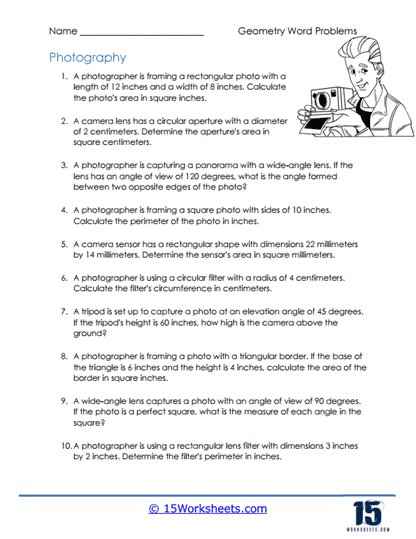Photography

Worksheet Description
This worksheet integrates geometry with the theme of photography to create a set of word problems. The problems require the application of geometric principles to various photography-related situations, such as calculating the area of a rectangular photo, determining the area of a camera lens’s circular aperture, and figuring out the angles in a panoramic photo. Students are asked to work with different geometric shapes and concepts, applying them to practical tasks that a photographer might encounter, like framing a photo or using a tripod.
The worksheet’s goal is to teach students how to apply geometric formulas to real-world situations, specifically within the field of photography. It focuses on reinforcing the students’ ability to calculate areas, perimeters, and angles of different shapes, such as rectangles, circles, and triangles. The problems are designed to enhance critical thinking by requiring students to solve for dimensions and understand geometric relationships in photography. Through these exercises, the worksheet seeks to deepen the students’ understanding of geometry as a useful tool in practical applications.
Example Problems
1. A photographer is framing a rectangular photo with a length of 12 inches and a width of 8 inches. Calculate the photo’s area in square inches.
2. A camera lens has a circular aperture with a diameter of 2 centimeters. Determine the aperture’s area in square centimeters.
3. A photographer is capturing a panorama with a wide-angle lens. If the lens has an angle of view of 120 degrees, what is the angle formed between two opposite edges of the photo?
4. A photographer is framing a square photo with sides of 10 inches. Calculate the perimeter of the photo in inches.
5. A camera sensor has a rectangular shape with dimensions 22 millimeters by 14 millimeters. Determine the sensor’s area in square millimeters.
6. A photographer is using a circular filter with a radius of 4 centimeters. Calculate the filter’s circumference in centimeters.
7. A tripod is set up to capture a photo at an elevation angle of 45 degrees. If the tripod’s height is 60 inches, how high is the camera above the ground?
